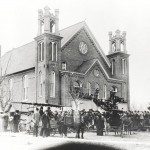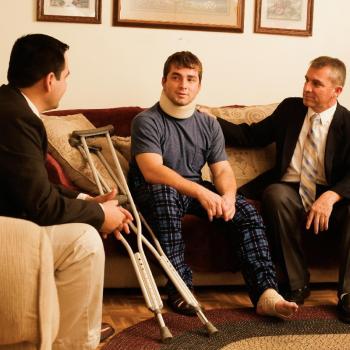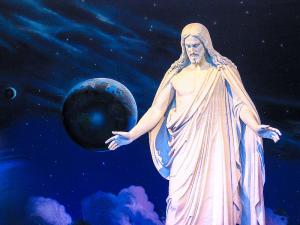About two years ago Ralph Hancock, a BYU professor of political philosophy, met with the Claremont Mormon Studies Student Association. As I reflected on the ensuing conversation, which had quickly veered into the troubled waters of Mormonism and same-sex marriage, I formulated two questions which I feel would have turned the discussion down less well-trodden—and hence potentially more productive—paths.
First, I would have asked Hancock, “As non-heterosexuality poses existential questions categorically unparalleled by most other Mormons’ faith troubles, what are the pastoral responsibilities of heterosexual Mormons and the LDS Church to those among us who are, to some degree, non-heterosexual?”[1]
I want to emphasize the second, though: “How might non-heterosexuals live as Mormons, interacting deeply with their faith even with its heterosexually-oriented theology and community?”[2] In this I evince a concern similar to that of Neylan McBaine’s recent book Women at Church: even if there were no changes to present LDS regulations or teachings, how could we work together to better embrace non-heterosexuals and other celibate singles (instead of women, who are McBaine’s subject) striving to live as faithfully as possible in Zion?[3]
These questions animated me to read Eve Tushnet’s new book Gay and Catholic: Accepting My Sexuality, Finding Community, Living My Faith.[4] In the first part of her book Tushnet, a blogger, uses her autobiography to illuminate questions of identity, conversion, and overcoming trial. We follow her through her atheist/Reform Jewish upbringing to her “coming out” as a lesbian at age 13; her discovery of and conversion to Catholicism at college; and her adult struggles with alcoholism and non-struggles with homosexuality. Following this are reflections on how a homosexual Catholic who holds to the Catholic teaching of celibacy can replace a negative identity (“I cannot have homosexual relations”) with positive ones focused on developing one’s vocation to sacrificial love, including through intimate spiritual friendship.
Along the way, Tushnet sensitively dismantles myths about homosexuals and their sexuality frequently peddled by self-styled opponents and allies. Homosexuality, for instance, is neither about narcissism (loving persons of your own gender) or gender non-conformity (wherein you are attracted to the gendered traits in which you are deficient). She questions the utility of origin narratives, arguing that “born this way” discourse denies the fluidity and malleability many people experience in their sexuality and that psychobiography—especially when it indiscriminately imposes its overblown theories of trauma or familial dysfunction—can be distracting at best and destructive at worst.
At its most basic, Tushnet’s message is a fantastic corrective to the excessive simplicity of our cultural narratives about sexuality that assume uniformity in its importance to people’s identity, the intensity of their desires, and the objects of their attractions. Equally diverse are the particular ways in which people are drawn to commune with God and neighbor, none of which need be tied essentially to sexuality. Not every homosexual Catholic is called to be a priest, monk, or nun.
Tushnet also denies that activism is the apex of discussions about homosexuality and advocates seeking community in the midst of debates on public policy. Indeed, she compares her discomfiting attendance at friends’ gay marriages to an atheist friend’s attendance at her own Catholic baptism: demonstrating admirable personal loyalty by descending with a loved one into the perceived “belly of the beast.” This mindset, combined with thoughtful gradualism, could prove useful for Mormons who find themselves working through the social consequences of their religious opposition to legal gay marriage.
While Tushnet limits her specifically Catholic advice more than I anticipated, some of her presumably generic observations and solutions are difficult to apply to Mormonism. Mormonism, for one, lacks even the monastic orders too often prescribed to homosexual Catholics.
Furthermore, the unmarried Catholic might be somewhat socially marginal in her parish, but the unmarried Mormon faces greater ecclesiastical marginality because of mandatory congregational divisions by geography, age, and marital status.[5] While specialized church units can provide deeply beneficial opportunities to collaborate in Zion and polish oneself, they can militate against healthful relationships that cross congregational lines. While for Catholics the formation of single/married friendships is a matter of reaching out within a parish, in the Mormon context these friendships require transcending ecclesiastical barriers that define almost your entire religious social life.
Moreover, the fact that unmarried Mormons in singles wards are presided over by three married men and their wives—unhelpfully but frequently conceived as surrogate parents—until age 30 (or even 45) can bestow on Mormon singles the stink of eternal adolescence.[6] With this partly in mind, a (single) friend of mine suggested that singles be reincorporated into typical “family” wards at age 25 instead of 31 (or 46). In some areas of the United States, Church leaders have adopted a mixed strategy: singles attend “family” wards, but within each stake (comparable to a diocese) one ward is designated as a “magnet” ward for singles. In this way, there is institutional support for singles’ unique challenges without the stark ecclesiastical isolation from family life, adolescents, or children. I myself have been blessed to have several friends from singles units pass into marriage without disappearing from my web of friendships, but attaining the sort of familial acceptance that Tushnet recommends—as an uncle or brother, not an occasional guest—would prove more difficult.
Another aspect of Mormon institutionalism that could frustrate Tushnet’s suggestions is Mormonism’s bureaucratization of the Christian concept of vocation. The supposed synonym that the LDS Church employs—“calling”—refers not to an inwardly perceived, divinely directed impulse to some action or position. Instead, a calling is a position in an organizational chart to which one is temporarily assigned by someone higher in the church hierarchy. This means that a single Mormon’s search for a Tushnet-style vocation can be constrained by the time commitments of one’s assigned “calling” or even seen as subversively rebelling against community by neglecting or refusing to serve in the proper way. On the contrary, however, this could serve as a boon to some single Mormons. Whereas the participation in religious community for many Catholics and Protestants has a baseline experience of passivity (say, church attendance), the baseline for Mormons is active; congregational leaders try to make sure that every Mormon has a responsibility. While a Mormon might face difficulties in discerning God’s plan for her, in the meantime she has a list of people to visit, classes to teach, sermons to give, activities to arrange, and so forth.
Speaking of “vocation,” Tushnet argues that Catholic singles (gay and otherwise) have suffered from a sometimes myopic focus on sacraments. In Catholic circles, she reports, “vocation” is often conflated with the Priesthood.[7] Similar difficulties can occur in Mormon circles: events and relationships not commemorated by the performance of a sacred ordinance are often given short shrift. Mormonism’s saving ordinances provide a roadmap to exaltation, but an undue focus on them can ignore the many facets of human experience without a special ritual formalization, like friendship.[8] The resultant laser-focus on marriage exacerbates the American fetishization of romance as the exclusive conduit for emotional intimacy, which Tushnet decries.
Notwithstanding its problems, it is hard to argue that this focus on matrimony is unjustified on an earthly or a heavenly level. Mormons have a history of attempting to construct intimate communities outside of nuclear familial structures, whether through economic communalism, geographic isolation, or by expanding the family’s reach through polygamy; however, unlike Catholic monasteries and convents—which faced their own opposition—Mormon communal practices were terminated by government order at gunpoint. Bereft of these connections and facing the geographically transient society of contemporary America, wherein lasting relationships might only survive between family members, doubling down on familial integrity might have been the best option.
Further, as a Catholic, Tushnet is able to reject marriage in the resurrection; earthly marriage is a soteriologically optional prefiguration of something greater, and heavenly heterosexuality is nonsensical. In Mormonism, by contrast, marital and family relationships are understood, ideally, to be eternal; only heterosexual couples can achieve the highest level of heaven. “That same sociality which exists among us here,” goes the verse, “will exist among us there, only it will be coupled with eternal glory, which glory we do not now enjoy” (D&C 130:2); marital relationships are to be glorified, but not fundamentally changed.[9]
This verse, however, also suggests that non-familial relationships could be eternally glorified; after all, they are a part of our earthly “sociality.”[10] With that in mind, we should remain alert for opportunities to create new forms of community to serve those on familial margins. And we should actively encourage friendship and Christlike service between families and singles, gay or not.
But such encouragement faces cultural obstacles. Tushnet suggests that we tear down myths that nip such spiritual friendships in the bud. Chief among these, she says, is that those with homosexual attractions should not have friends of the same sex, lest they give in to temptation.[11] This reduces homosexuals to sexuality alone. Sadly but ironically, it also ignores that in our relatively gender-segregated upbringings, homosexuals often have more opportunity to learn how to interact non-sexually with those to whom they are attracted than do heterosexuals. Mostly, however, this myth constitutes a ban on friendships and threatens to condemn many single, homosexual Christians to a life of perpetual loneliness. Tushnet sees in this state of despair and perceived worthlessness an environment even more prone to temptation than one of homosociality.[12]
In the end, I believe that Eve leaves us with two lessons. First, it is not good for man or woman, straight or not, marriageable or not, to be alone. Second, everyone has the responsibility and opportunity to build communities in which no one is left out. While the specifics of the Catholic experience may be different or in some cases incommensurate with LDS teachings, I would still recommend this book to Mormons to enhance their understanding of their fellow beings’ challenges and as a guide pointing them towards Zion.
[1] I recognize that this seems to draw a (false) distinction between “non-heterosexuals” and “Mormons” or “the LDS Church,” but if the Church is seen as embodied in its hierarchy, non-heterosexuals have very little presence. When a homosexual executive secretary or bishopric member is cause for headlines, I do not believe that we can say that non-heterosexuals are not de facto marginal in LDS culture. A further clarification: I use “non-heterosexual” to include bisexuals (attracted to both sexes) and asexuals (attracted to neither sex), both of which face unique issues in Mormon practice. I omit transgender people despite their inclusion in “LGBT,” for gender identity is a theologically and practically distinct question from sexual orientation.
[2] I approach this subject with no small trepidation, for I know that I will never read all the millions of words spilled on the subject and may well be repeating the essence of some of them. I avoid “heteronormative” given its extensive baggage that I do not wish to invoke.
[3] In fact, while writing this post I found another Mormon blogger proposing the same question.
[4] Special thanks to Leah Libresco of Unequally Yoked for both recommending the book and providing my copy!
[5] While Mormons can choose not to attend a singles ward, that can often result in significant isolation from other members of their peer groups and can occasion social disapprobation. There are also many places around the world where there are no singles congregations; in those locations, while they will likely be given responsibilities in their local congregations, they might still face isolation from family-based activities. This could be especially acute if they have no Mormon relatives themselves.
[6] In some cases, an unmarried man can be a member of a local congregation’s leadership; however, it is more common to have three married men.
[7] Tushnet then continues on to speak about times in history where there were ordinances of vowed friendship peculiarly reminiscent of present-day conceptions of marital vows.
[8] The exception could be the Sacrament, which is a weekly reminder of Christ; however, this is also universal. Also, I was pleased this past Sunday to hear a teacher ask her class whether they had perceived a personal called to help out another; unfortunately, this question was followed by a story in which a bishop assigned members of his congregation to each other as friends.
[9] The Mormon folk doctrine that non-heterosexuals will find their sexuality realigned after death begs a host of questions, primarily what sexual attraction means to an immortal being. What does attraction, an evolutionary mechanism to ensure pairing and reproduction, mean when pairs are either sealed and immutable or impossible to form? Will asexuals, who experience no sexual attraction in mortality, wake in the morning of the first resurrection entranced by their fellow celestials’ curves and angles? What does immortality itself mean when the only bodies with which we have any experience are built to reproduce before, and perhaps because, they decay?
[10] Some visions of Mormon soteriology extend community to the non-human realm; various authorities, including Joseph Smith, have averred that humans’ companion animals will be with them in the Resurrection.
[11] Not counting the unjust and inaccurate characterization of all homosexual people as pedophiles, a common notion through the 1990s and still current in some circles.
[12] “Homosocial” refers to non-sexual relationships between members of the same sex.












